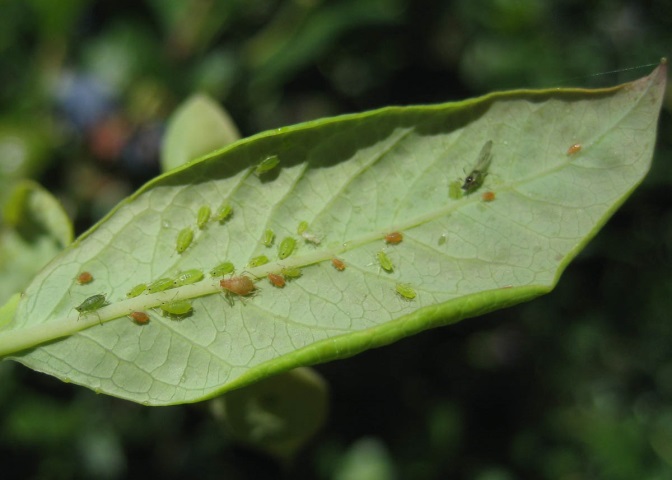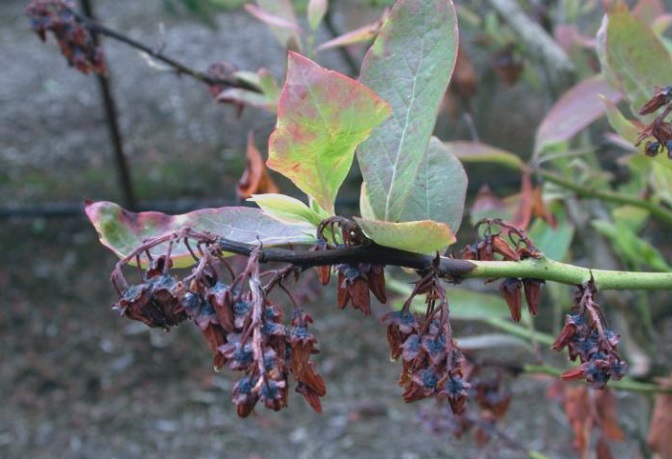
Blueberry aphid and blueberry scorch virus
| Primefact number | Edition | Published | Author |
|---|---|---|---|
| 1620 | First | Dec 2017 | Plant Biosecurity and Product Integrity |


Blueberry aphid (Ericaphis fimbriata) is the main vector of blueberry scorch virus (BIScV). Neither the aphid nor the disease is known to occur in Australia. This insect-disease complex is exotic to Australia and poses a serious threat to Australia’s blueberry industry.
Notifiable status
If you suspect blueberry aphid (Ericaphis fimbriata):
- Call the Exotic plant pest hotline 1800 084 881
- Email: biosecurity@dpi.nsw.gov.au and provide a clear photo and your contact details
- Report online: online form
Description
Blueberry aphid
Blueberry aphids appear similar to other aphid species. They are usually found gathered in colonies on new growth, the undersides of leaves, and near flower and fruit clusters of blueberry plants. On closer inspection blueberry aphids are 1–2 mm in length, pear shaped, light yellow to green in colour and wingless. A few winged adults may occur and are blackish in colour.
Blueberry scorch virus (BIScV)
Symptoms of BIScV vary largely according to virus strains and host type. Some plant varieties may show severe blossom blight, leaf blight and twig dieback, while others may not show any symptoms. However, all highbush blueberry varieties appear to be susceptible.
Other signs of BIScV infection can include red line patterns on leaves, yellowing of leaf margins, leaf mottling, overall pale colour, low number of blossoms, or even a ‘twiggy’ appearance.
It may take up to two years after initial infection before symptoms start to develop.
Symptoms of BIScV may be confused with bacterial or fungal diseases, frost injury or nutrition deficiency and therefore testing is required to confidently identify the virus.
Damage
Once a plant becomes infected with BIScV it is infected for life. Severely blighted bushes bare little fruit. In the years following initial infection bushes become very twiggy and the fruit load is markedly reduced compared to healthy plants. The productivity of infected plants declines each year, eventually leading to plant death.
Apart from transmitting BIScV, blueberry aphids also impact plant health by secreting honeydew and encouraging mould growth. Their feeding can deform leaves and reduce plant vigour.
Lifecycle
Female aphids can continuously maintain and grow an aphid population without mating by producing cloned offspring. In favourable conditions, winged females and males may be produced for mating and population distribution. Populations can overwinter either as eggs or sheltered adults.
BIScV is transmitted by aphids feeding on infected plants and then moving to feed on a new host, effectively injecting the virus into the plant.
Host range
Known hosts of blueberry scorch virus include highbush blueberry (Vaccinium corymbosum) and cranberry (Vaccimium macrocarpon), though cranberry appears to be symptomless.
More research is required to determine if other Vaccinium species are hosts for BIScV as well.
Quinoa (Chenopodium quinoa) has also proved to be a susceptible host plant under lab conditions.
Spread
Aphids can spread locally by flying or up to a few kilometres by wind dispersal, transmitting BIScV with them. BIScV can also be spread with infected grafting or propagation material.
Long distance spread of blueberry aphid and BIScV is most likely to occur with the transport of infected plant material.
Distribution
Blueberry aphid and BIScV have been reported from the United States and Canada in North America and the Netherlands, Italy and United Kingdom in Europe.
Actions to minimise risk
Put in place biosecurity best practice actions to prevent entry, establishment and spread of pests and diseases:
- practice “Come clean, Go clean”
- ensure all staff and visitors are instructed in and adhere to your business management hygiene requirements
- source propagation material of a known high health status from reputable suppliers
- monitor your plants regularly
- keep records

